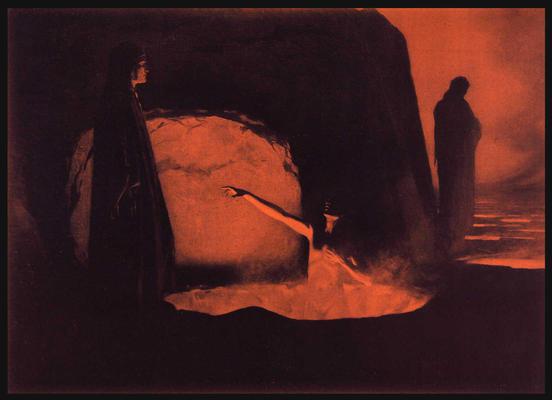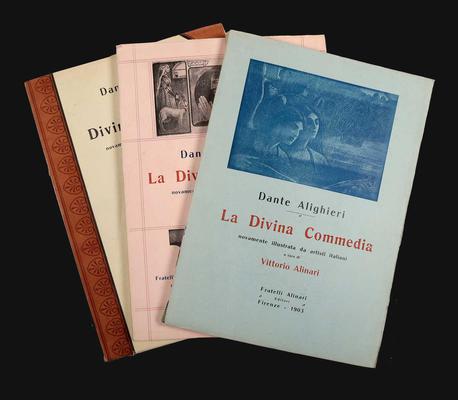Dante Alighieri
La Divina Commedia nuovamente illustrata da artisti italiani a cura di Vittorio Alinari.
Florence, 1902-1903.Three volumes, 371 x 263 mm. [2], xvi, [2], 140; [8], 146, [2]; [6], 166, [2] pages. 381 illustrations by fifty-nine Italian artists, including thirty-six plates printed on cardboards. Original editorial wrappers (white for theInferno; pink for thePurgatorio; pale blue for theParadiso), and printed in red and black. A very fine copy.
The illustrations made by 59 Italian artists for this edition of the Commedia – whose text was edited by the philologist Giuseppe Vandelli (1856-1937), who also signed the preface, are the result of a contest organized by Vittorio Alinari in May 1900. Each competitor had to send three drawings by March 1901 (one head piece, one tail piece and one plate for each canto) for at least three cantos of theInferno.The submitted works were exhibited at La Società di Belle Arti in Florence from the 13th to the 25th of June 1901 and judged by a commission which awarded the first prize (L. 500) to Alberto Zardo for the illustration of the canti VIII and IX, the second one (L. 250) to Armando Spadini for the illustrations of the canti XIII and XXV. A third prize was equally divided between Duilio Cambellotti and Ernesto Bellandi. During the same period, Alinari also commissioned the illustrations of the others two cantiche. The artists who participated in the competition were: Libero Andreotti, Tommaso Baldini, Lionello Balestrieri, Carlo Balestrini, Giulio Bargellini, Alfredo Baruffi, Augusto Bastianini, Ernesto Bellandi, Silvio Bicchi, Giovanni Buffa, Arturo Calosci, Duilio Cambellotti, Illemo Camelli, Pietro Chiesa, Galileo Chini, Giovanni Costetti, Gaele Covelli, Adolfo De Carolis, Pietro De Francisco, Fabio Fabbi, Arturo Faldi, Natale Faorzi, Giovanni Fattori, Egisto Ferroni, Ruggero Focardi, Riccardo Galli, Giorgio Kienerk, Vincenzo La Bella, Cesare Laurenti, Giacomo Lolli, Serafino Macchiati, Adolfo Magrini, Augusto Majani, Alessandro Marcucci, Filippo Marfori Savini, Alberto Martini, Cesare Martini Franchi, Ezio Marzi, Giovanni Mario Mataloni, Gino Melis, Giuseppe Mentessi, Alberto Micheli, Giuseppe Miti Zanetti, Anton Maria Mucchi Vignoli, Carlo Muccioli, Augusto Paolo Mussini, Plinio Nomellini, Camillo Pagliucchi, Edgardo Saporetti, Giulio Aristide Sartorio, Pietro Senno, Aldo Sguanci, Armando Spadini, Giorgio Szoldatics, Alberto Tedeschi, Osvaldo Tofani, Ludovico Tommasi, Giovanni Trombara, Angelo Vernazza, Alberto Zardo. The printer Salvatore Landi used the best photomechanical processes of the Era in order to reproduce the drawings on the paper produced by the firm Vonwiller and C. at Romagnano-Sesia (near Novara, in Piedmont) The work is a graphical masterpiece that has its roots into the Symbolism of the late nineteenth century and in the same time anticipates the development of the Art Nouveau.



